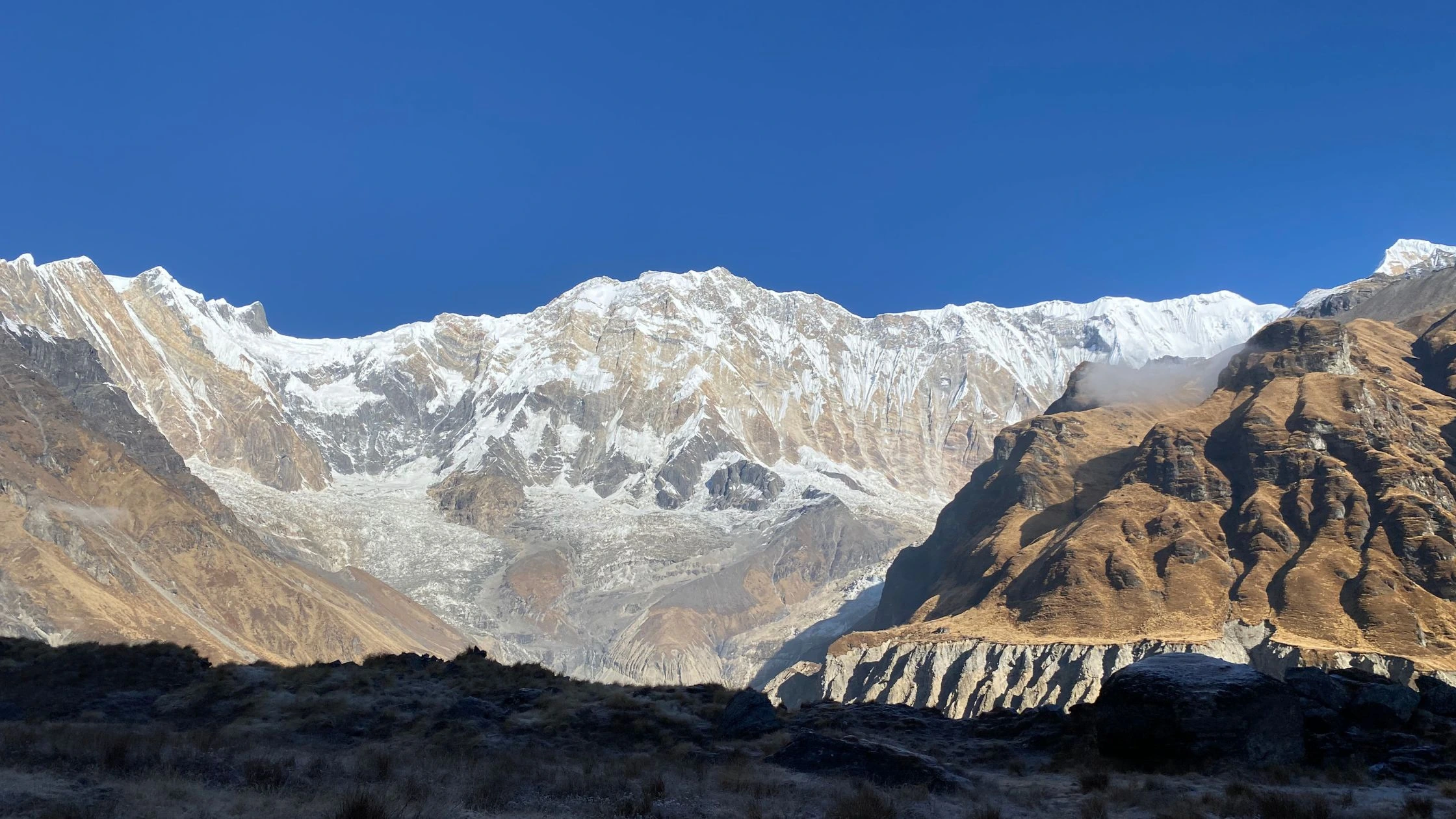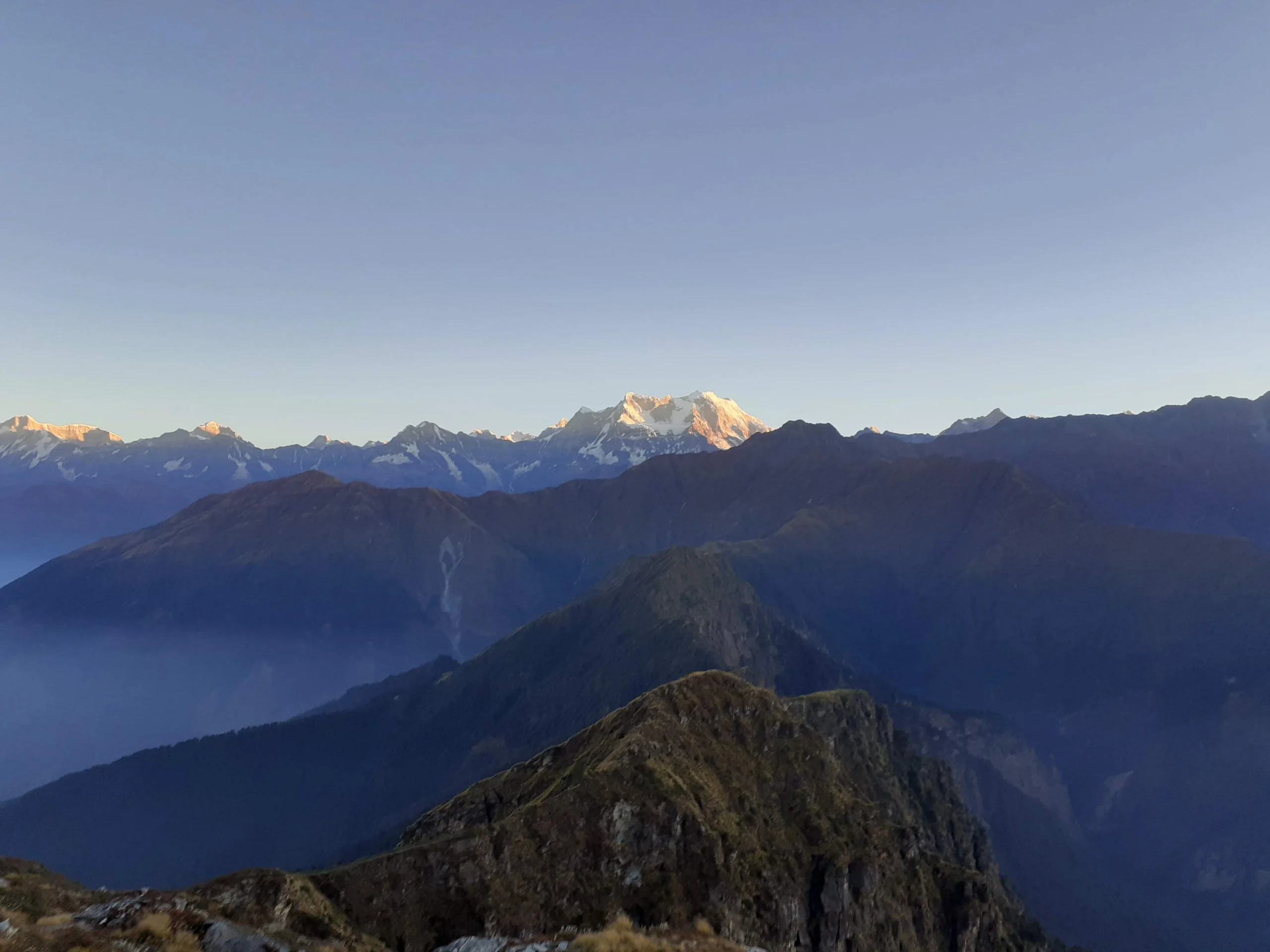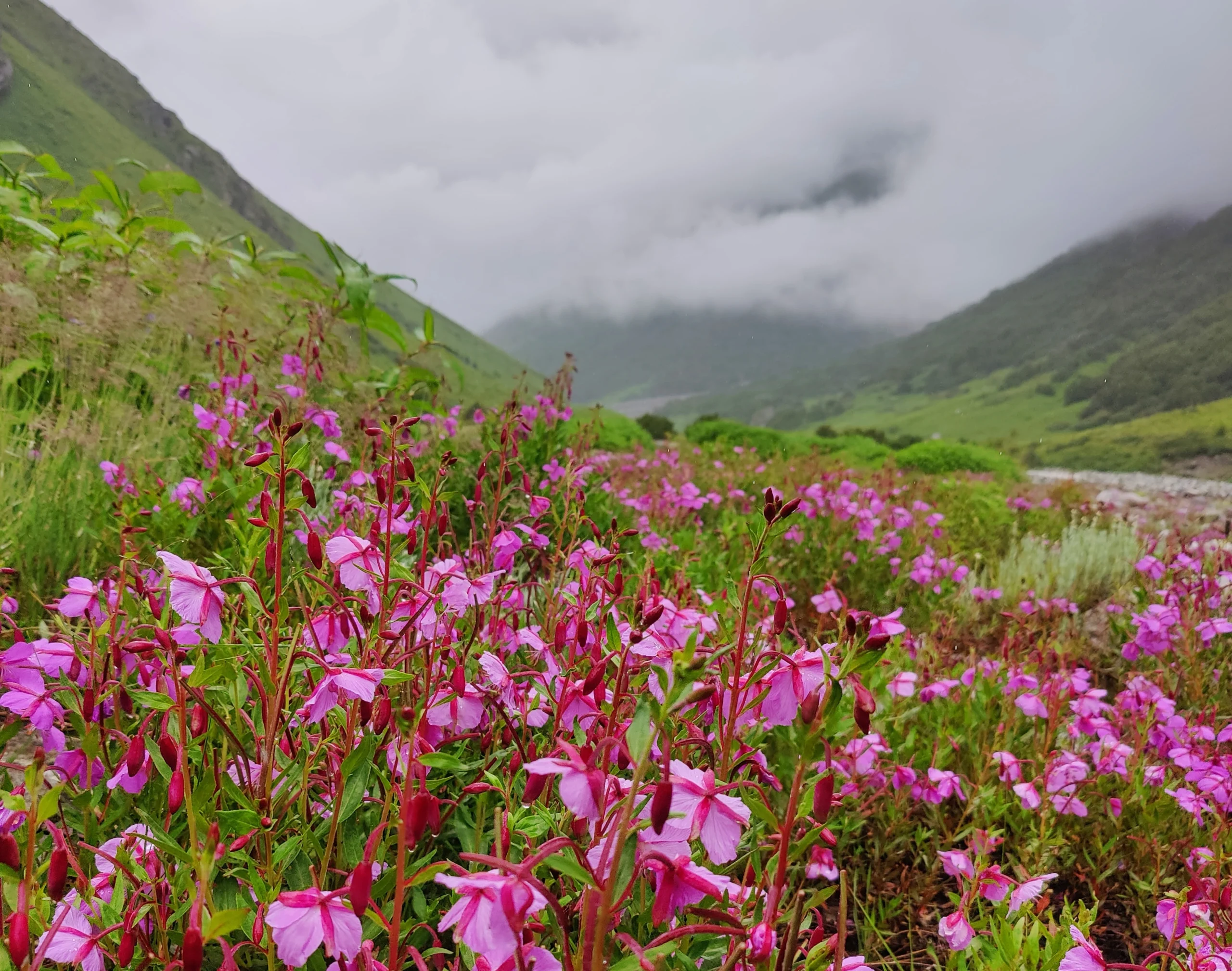The Annapurna Base Camp (ABC) Trek is a bucket list adventure for trekkers worldwide. It offers a front-row seat to some of the most dramatic Himalayan peaks, including Annapurna I (8,091m), Machhapuchhre (6,993m), and Hiunchuli (6,441m). It’s located in Nepal’s Annapurna Sanctuary at 4,130m. This trek combines rugged trails, vibrant Gurung and Magar villages, and jaw-dropping mountain vistas. But timing your trek is really important as weather, trail conditions, and crowds vary drastically by season.
In this detailed guide, we’ll break down the best time to visit Annapurna Base Camp Trek, seasonal weather patterns, practical tips, and how to align your priorities with the right months.
All You Need To Know About the Annapurna Base Camp Trek
The Annapurna base camp trek is a moderate-to-challenging journey that spans approximately 7–12 days, depending on your itinerary and pace. Starting from Pokhara, the trail winds through lush rhododendron forests, terraced farmlands, and alpine meadows, culminating at the base camp surrounded by a 360° panorama of snow-capped peaks.
The total distance is roughly 110–120 km round trip, with daily ascents and descents on stone steps and rugged paths. Key highlights include sunrise views from Poon Hill, hot springs at Jhinu Danda, and cultural immersion in villages like Ghandruk.
The trek is accessible year-round, but weather plays a great role in shaping your experience. Spring and autumn are peak seasons, while winter and monsoon present unique challenges. Let’s learn about the weather by season to understand what to expect.
Overview of Annapurna Base Camp Weather by Season
Nepal’s Annapurna region experiences four distinct seasons, each with its own weather patterns, temperatures, and trail conditions.
Spring (March–May)
- Temperature: Daytime: 10°C to 20°C at lower elevations; 0°C to 8°C at ABC. Nighttime: -8°C to 5°C.
- Weather: Mild, stable, and dry with clear skies. Snow melts at higher altitudes, and rhododendron forests bloom in vibrant pinks and reds.
- Pros: Pleasant trekking conditions, stunning mountain views, and colorful landscapes. Ideal for photography and nature lovers.
- Cons: Crowded trails and teahouses, especially in April. Pre-booking accommodations is essential.
Summer/Monsoon (June–August)
- Temperature: Daytime: 15°C to 25°C at lower elevations; 5°C to 10°C at ABC. Nighttime: 0°C to 7°C.
- Weather: Hot, humid, and rainy, with frequent showers and occasional landslides. Trails are muddy and slippery, and leeches are common. Cloud cover often obscures mountain views.
- Pros: Lush, green landscapes and fewer trekkers. Waterfalls are at their peak.
- Cons: High risk of rain, poor visibility, and challenging trail conditions. Not recommended for beginners.
Autumn (September–November)
- Temperature: Daytime: 12°C to 20°C at lower elevations; 0°C to 10°C at ABC. Nighttime: -4°C to 5°C.
- Weather: Dry, stable, and crisp with clear blue skies. Post-monsoon freshness enhances visibility, making it the best season for mountain views.
- Pros: Optimal trekking conditions, vibrant festivals (Dashain and Tihar), and crystal-clear Himalayan vistas.
- Cons: Extremely crowded trails, especially in October. Teahouses and guides book up months in advance.
Winter (December–February)
- Temperature: Daytime: 5°C to 12°C at lower elevations; -10°C to 5°C at ABC. Nighttime: -15°C to 0°C.
- Weather: Cold and dry, with occasional snowfall at higher altitudes. Clear skies are common, but heavy snow can block trails. Foggy mornings may clear up by midday.
- Pros: Quiet trails, stunning snow-covered peaks, and off-season discounts on accommodations.
- Cons: Freezing temperatures, avalanche risks, and potential trail closures. Requires advanced preparation and cold-weather gear.
Best Months to Trek Annapurna Base Camp
Based on weather, visibility, and trail conditions, the best months to trek Annapurna Base Camp are April and October, with March, May, September, and November as strong alternatives. Here’s a comparison table to help you decide:
| Month | Weather | Temperature (ABC) | Crowds | Visibility | Pros | Cons |
| March | Mild, dry, blooming flora | 4°C to -8°C | Moderate | Good | Vibrant landscapes, fewer crowds | Some snow at higher altitudes |
| April | Warm, clear skies | 8°C to -4°C | High | Excellent | Ideal conditions, rhododendron blooms | Very crowded, book early |
| May | Warm, pre-monsoon showers | 14°C to 0°C | Moderate | Good | Warmer days, lush valleys | Haze possible, early monsoon risk |
| September | Post-monsoon, clearing skies | 15°C to 5°C | Moderate | Good | Lush trails, fewer crowds than Oct | Occasional rain, muddy patches |
| October | Dry, crisp, clear | 12°C to 0°C | Very High | Excellent | Perfect weather, festive atmosphere | Overcrowded, expensive accommodations |
| November | Cool, dry, stable | 10°C to -4°C | High | Excellent | Clear views, quieter than Oct | Colder nights, shorter days |
Note: December, January, and February are viable for experienced trekkers comfortable with cold weather, while June–August are best avoided unless you’re prepared for rain and limited views.
Tips for Trekking in Different Seasons
To upgrade your Annapurna Base Camp Trek experience, match your preparation to the season. Here are season-specific tips:
Spring (March–May)
- Gear: Pack layers (fleece, thermal base layers, waterproof jacket), sturdy trekking boots, and sunglasses for sun protection. A sleeping bag rated for -10°C is recommended for higher altitudes.
- Training: Build stamina with cardio and stair-climbing to handle daily ascents. Acclimatize properly to avoid altitude sickness.
- Planning: Book teahouses and guides in advance, especially for April. Check weather forecasts for early May to avoid pre-monsoon showers.
- Tip: Start early each day to enjoy clear morning views and avoid afternoon crowds at viewpoints.
Summer/Monsoon (June–August)
- Gear: Waterproof jacket, pants, and gaiters are essential. Use trekking boots with strong grip for slippery trails. Carry insect repellent for leeches.
- Training: Focus on endurance for muddy, uneven terrain. Practice hiking in wet conditions if possible.
- Planning: Hire an experienced guide familiar with monsoon routes. Avoid trekking alone due to landslide risks. Monitor weather updates daily.
- Tip: Embrace the lush scenery and pack a camera with a waterproof case for misty landscapes.
Autumn (September–November)
- Gear: Layered clothing (moisture-wicking base, fleece, down jacket), a warm hat, and gloves for chilly mornings and evenings. UV-protective sunglasses are a must.
- Training: Prepare for long trekking days with strength exercises and high-altitude simulation if possible.
- Planning: Reserve accommodations and permits early, especially for October. Consider alternative routes like Mardi Himal to avoid crowds.
- Tip: Join local festival celebrations (Dashain in Oct, Tihar in Nov) for a cultural bonus.
Winter (December–February)
- Gear: Heavy-duty cold-weather gear (down jacket, thermal layers, insulated gloves, crampons for icy trails). A sleeping bag rated for -20°C is critical.
- Training: Build mental resilience for cold conditions. Train in low temperatures to test gear and comfort.
- Planning: Check trail conditions with local agencies, as heavy snow may close higher routes. Travel with a guide experienced in winter trekking.
- Tip: Carry a thermos for hot drinks to stay warm at ABC. Trek during midday to avoid foggy mornings.
How to Choose the Best Time Based on Your Priorities
The best time to visit Annapurna Base Camp Trek depends on what you value most. Here’s how to align your priorities with the right season:
- Clear Mountain Views and Photography: Prioritize October or April for crystal-clear skies and unobstructed Himalayan vistas. Autumn (Sep–Nov) offers post-monsoon clarity, while spring (Mar–May) pairs views with blooming flora. Avoid monsoon (Jun–Aug) due to cloud cover.
- Fewer Crowds: Opt for late February, early March, late May, or early September. These shoulder months have stable weather but fewer trekkers than peak seasons. Winter (Dec–Feb) is the quietest but demands cold-weather expertise.
- Cultural Immersion: Trek in October or November to experience Nepal’s vibrant festivals, Dashain and Tihar, which bring villages to life with music, dance, and rituals. Spring’s Holi festival (March) adds color to lower-elevation stops like Pokhara.
- Budget Travel: Choose winter (Dec–Feb) for off-season discounts on teahouses and guides, but be ready for cold. Early September or late May can also be cost-effective with fewer crowds.
- Adventure and Challenge: Tackle winter (Dec–Feb) for a rugged experience with snow-covered trails, or brave monsoon (Jun–Aug) for solitude and lush scenery, provided you’re equipped for rain and landslides.
Additional Considerations for Planning Your Trek
- Permits: You’ll need an Annapurna Conservation Area Permit (ACAP) and a TIMS card. Obtain these through a registered trekking agency or in Pokhara/Kathmandu.
- Fitness Level: The trek involves 6–8 hours of daily walking with steep ascents. Train for 2–3 months with cardio, strength, and stair-climbing exercises.
- Altitude Sickness: ABC’s elevation (4,130m) poses a risk. Ascend gradually, stay hydrated, and consider Diamox if advised by a doctor.
- Guides and Porters: Hiring a licensed guide is recommended, especially in off-seasons. Porters can carry up to 15–20 kg, easing your load.
- Weather Unpredictability: Himalayan weather can change rapidly. Always carry layers, a waterproof jacket, and check local forecasts before setting out.
Conclusion
The Annapurna Base Camp Trek is a once-in-a-lifetime adventure that carves itself into your memory. But when you go can completely change the experience. If you’re chasing postcard-perfect weather and jaw-dropping mountain views, April and October are the sweet spots.
Prefer fewer people but still want decent conditions? March, May, September, and November strike that golden middle ground.
Now, if you’ve got a taste for adventure and don’t mind the cold, winter gives you snowy trails and peaceful silence. On the flip side, the monsoon season paints everything green and alive but it will be a struggle.
Pick your moment, start prepping, lace up those boots, and get ready to feel the power of the Himalayas all around you.
If you are looking for vibrant experience in the himalayas connect with: mountainiax











